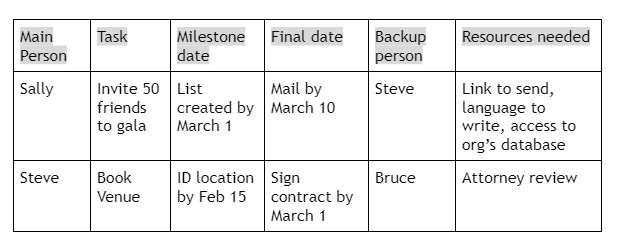How to Create a Simple Yet Effective Fundraising Plan
Elements of a development plan
Fundraising can feel complicated and overwhelming. Many nonprofit organizations are swimming in fundraising ideas but are not sure where actually to begin. Should you research grants and apply for them or focus on producing an event? Should you do an email blast to supporters or put your energy into major donor-matching gifts?
No organization or fundraiser has the capacity to do everything they want to do. So it helps to: 1) narrow, 2) prioritize, 3) delegate, and 4) set deadlines. The best way to do this is by creating a fundraising plan.
What is a Fundraising Plan?
A fundraising plan is a simple written document for how you will achieve your organization’s annual fundraising goals. Your fundraising plan should break down WHO will raise money in WHAT ways by WHEN.
Development plans do not need to be complicated or long. Your fundraising plan can be as short as 1-2 pages. As your organization gets larger or more sophisticated in its approach, your plan will shift and adapt. But to get started, do not be intimidated.
You can also grab the template I use myself to make the overwhelming work seem soooooo much easier by having a clear division of labor.
How to Create a Simple Fundraising Plan
Step One: Identify Your Goals
Your fundraising plan always starts with goals. This could be a financial goal like, “We will raise $250K in 2023.” Or it could be tied to other metrics: “We will get 500 dues-paying members this year.” Either way, your plan will be constructed in order to hit your fundraising goals (dollars or donors).
Step Two: Prioritize Tactics
The next step is to develop and prioritize tactics. Be strategic. If you only have so much capacity, where do you want to put your efforts? You probably want to invest in the tasks that are either the easiest or the most likely to succeed.
In order to reach your fundraising goal, each tactic in your development plan must add up to at least the total plan goal. For example:
Fundraising Goal: $80k
Gala: $30k
Mail appeal: $10K
Monthly sustainers: $5k
Facebook fundraisers: $10k
Major donor solicitations: $10k
Donations from board members: $10k
Misc. donations from the website: $5k
Combined Total: $80
Once you break a big number into smaller bite-size tasks and goals, it all feels so much easier. As you get better at development planning you will get more and more accurate at projections. It’s ok if you don’t achieve the exact dollar amount in every category, but if you go way over or under a goal, you’ll want to adjust your goals for the following year.
Step Three: Put Your Fundraising Plan in Writing
Fundraising plans do not exist in your head. To be successful, you need alignment, agreement, transparency, and accountability. This is best achieved when everyone contributes to and can see a written plan.
There are a variety of simple yet effective formats you can use to put your fundraising plan down on paper. I recommend choosing the one that will be easiest for you and your team to translate into day-to-day work plans.
Here are four simple fundraising plan formats I’ve seen work especially well.
Simple Format 1: Bullets
The simplest development plan could be in paragraph or bullet form. One bullet or paragraph could be: “Becky and Sue have promised to send 100 personal invitations to their network by March 15 with a registration link to the April 10 Gala.” Notice that this includes the key elements of WHO will do WHAT by WHEN.
I proudly partner with Bloomerang as an affiliate because I believe in their solution. Click on the logo for a demo.
Simple Format 2: Chart
You can create a simple chart in Google Docs or MS Word like this:
Simple Format 3: Topics and Bullets
Based on my own work leading nonprofits, I created a fundraising plan template that combines funding streams with the bullet format above. This plan helps you think through how to raise more money from each category, such as foundations, major donors, events, etc.
Simple Format 4: Spreadsheet
Some organizations put their plan into a table or spreadsheet using MS Excel or Google Sheets. You can make your spreadsheet as elaborate as you like, but make sure to include the basics of who will do what and by when. For example:
Bonus Fundraising Plan Format: Video Recording
Even though your plan should be in writing, some folks may prefer to add to the plan as a short audio or video file. During a Zoom call or on your phone you can dictate the plan (and ideally have it transcribed). For example: “Hi this is Sean and today is Dec 1 and all of us on this call have decided the plan of attack for the April gala. I will book the venue by Feb 1. Becky will do all the decorations. She’ll get them purchased by April 1 and put them in the facility the day before with the help of Steve. Sue will serve as the Emcee and have her “run of show” script and plan completed by April 1”
Conclusion
In closing, a fundraising plan doesn’t have to be complicated. It can be a simple 1-2 page document that shows what your overarching fundraising goals are, and then WHO will do WHAT by WHEN to hit that goal. To get more detailed, you can assign milestones and secondary helpers. Rinse and repeat every year. Grab my sample development plan to get started.





